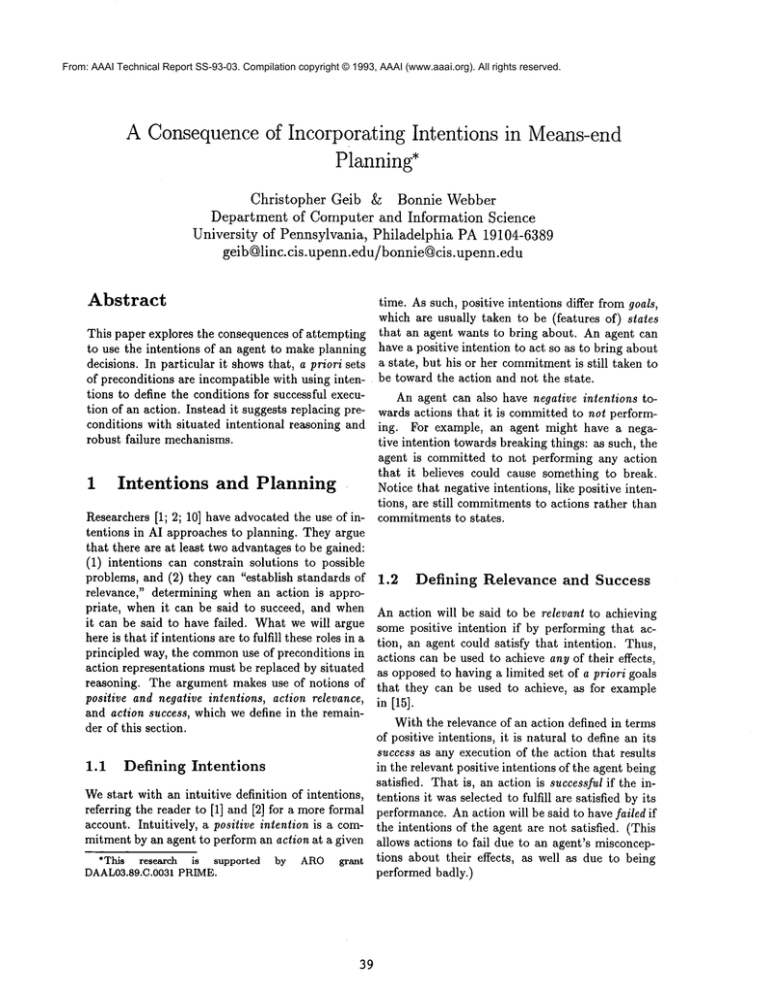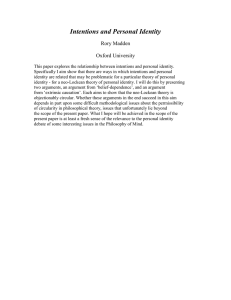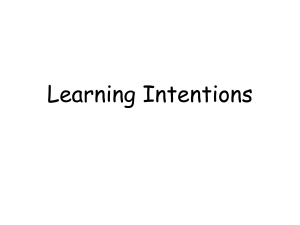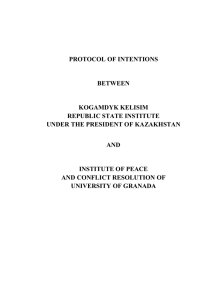
From: AAAI Technical Report SS-93-03. Compilation copyright © 1993, AAAI (www.aaai.org). All rights reserved.
A Consequenceof Incorporating Intentions in Means-end
Planning*
Christopher
Geib & Bonnie Webber
Department of Computer and Information
Science
University
of Pennsylvania,
Philadelphia
PA 19104-6389
geib@linc.cis.upenn.edu
’bonnie@cis.upenn.edu
Abstract
time. As such, positive intentions differ from goals,
which are usually taken to be (features of) states
This paper explores the consequences of attempting that an agent wants to bring about. An agent can
to use the intentions of an agent to make planning have a positive intention to act so as to bring about
decisions. In particular it showsthat, a priori sets a state, but his or her commitmentis still taken to
of preconditions are incompatible with using inten- be toward the action and not the state.
tions to define the conditions for successful execuAn agent can also have negative intentions totion of an action. Instead it suggests replacing pre- wards actions that it is committed to not performconditions with situated intentional reasoning and ing. For example, an agent might have a negarobust failure mechanisms.
tive intention towards breaking things: as such, the
agent is committed to not performing any action
that it believes could cause something to break.
1 Intentions
and Planning
Notice that negative intentions, like positive intentions, are still commitmentsto actions rather than
Researchers [1; 2; 10] have advocated the use of in- commitments to states.
tentions in AI approaches to planning. They argue
that there are at least two advantages to be gained:
(1) intentions can constrain solutions to possible
problems, and (2) they can "establish standards
1.2
Defining
Relevance
and Success
relevance," determining when an action is appropriate, when it can be said to succeed, and when An action will be said to be relevant to achieving
it can be said to have failed. What we will argue some positive intention if by performing that achere is that if intentions are to fulfill these roles in a tion, an agent could satisfy that intention. Thus,
principled way, the commonuse of preconditions in actions can be used to achieve any of their effects,
action representations must be replaced by situated as opposed to having a limited set of a priori goals
reasoning. The argument makes use of notions of that they can be used to achieve, as for example
positive and negative intentions, action relevance, in [15].
and action success, which we define in the remainWith the relevance of an action defined in terms
der of this section.
of positive intentions, it is natural to define an its
success as any execution of the action that results
1.1
Defining
Intentions
in the relevant positive intentions of the agent being
satisfied. That is, an action is successful if the inWestart with an intuitive definition of intentions,
tentions it was selected to fulfill are satisfied by its
referring the reader to [1] and [2] for a more formal performance. An action will be said to have failed if
account. Intuitively, a positive intention is a com- the intentions of the agent are not satisfied. (This
mitment by an agent to perform an action at a given allows actions to fail due to an agent’s misconceptions about their effects, as well as due to being
*This research is supported by AROgrant
DAAL03.89.C.0031PRIME.
performed badly.)
39
2
Preconditions
Defining the success and relevance of actions in
terms of intentions reveals a problem with preconditions that can be seen using a general definition
of preconditions developed from a suggestion made
by Pollack [10]. After presenting this definition and
showing how it covers both past and current views
of preconditions, we will show the problem in trying to reconcile it with intention-based notions of
success and relevance.
2.1
be referred to as generation conditions, and ones
that guarantee that an action is executable, will be
referred to as executability conditions.
It is not possible to use either clause alone for
a definition. Generation conditions alone will not
guarantee the executability of ~ and hence would
not guarantee the generation of/?. Conversely, executability conditions alone cannot guarantee that
the performance of ~ would generate ft. Thus, only
a conjunction of these conditions will suffice.
2.2
The Definition
In her thesis Pollack uses Goldman’s[5] generation
relation to relate actions. This relation holds between two actions when the occurrence of one constitutes an occurrence of the other. For example, in
a given game of chess the action "John moved his
queen to king-knight-seven" might generate "John
checkmatedhis opponent" [5, page 40]. Pollack formalizes Goldman’sdefinition of generation into the
CGENrelation. She defines an action a to conditionally generate (CGEN)action/3 under conditions C, if and only if the occurrence of a does not
always constitute an occurrence offl, the conditions
C do not always imply an occurrence of/~, and if the
conditions C do hold and (~ occurs, then fl occurs.
Pollack also defines a predicate EXEC,that defines those conditions in which an agent is physically
able to perform some action. Thus, EXEC(~, G,t)
is true if and only if there are no external forces
which would prevent agent G from performing action (~ at time t. A complete definition for this
predicate can be found in [10]
Nowfor a generic action represented by a header
(f~) and body (a), we define C as the preconditions
of the action if the truth of C allows a to generate
1~ and also guarantees the executability of a. Thus,
C states the preconditions of achieving the header
by performing the body. More formally:
PRECOND(C, fl,~)
, ,
[HOLDS(C,t) ---, VG EXEC(c~, t)]
CGEN(c~, ~, C)
Applying
the
Definition
As Pollack points out, "much of the existing
planning literature has been vague about the intended interpretation of action operators, and has
used them at different times to mean different
things." [10, page 74], In the following section we
will try to make precise howour definition captures
existing ideas about preconditions.
2.2.1
STRIPS-style
Preconditions
Preconditions are "...the conditions under which the
operator[action] is applicable." [3, page 192]. This
sentence, or one very much like it, appears as the
definition for preconditions in manyplanning systems (e.g. [8; 11; 15]). Preconditions thus identify those states from which the given action can be
taken: unless its preconditions are met, an action
cannot be attempted. Inadequacies in this definition have already been noted. For example, Hanks
points out that it "... confuses the notion of an action being meaningful or conceivable with the notion
of an action’s achieving its intended effect." [7, page
159] It is helpful though to consider such STRIPSstyle preconditions in terms of our definition. For
example, consider the following pickup operator
from [9, page 281] :
pickup(x)
preconditions: ontable(x),clear(x),handempty
delete list: ontable(x),clear(x),handempty
add list: holding(x)
That is, C is a precondition of/? by doing c~ if and
only if C is necessary to guarantee that there is no
physical impediment to the execution of c~ and C
allows a to generate ft. In this paper, conditions
that allow an action to generate another action will
4O
Its three preconditions are generation conditions,
under which the agent’s low-level actions generate
a pickup action. They do not, however, guarantee
that the action is executable.
2.2.2
ABSTRIPS
the following blocks world action.
ABSTRIPS,on the other hand, encodes both executability and generation conditions. In the following set of preconditions for an action to push an
object (bx) to another object (by),
TYPE(by, object), PU SH AB LE(bx),
N E X TTO( RO BOT, bx),
3rx[IgROOM(bx, rx) A IYROOM(by,
AINROOM(ROBOT,rx)] [11, page 125]
PUSHABLE(bx)is an executability
condition,
specifying the agent’s physical ability to perform
the action.
2.2.3
Applicability
Conditions
In NONLIN
[13], Tate defined what he calls usewhen conditions. They correspond to Schoppers’
applicability conditions [12]. Tate defines them by
saying "Conditions may be stated which must hold
before this expert[action] can be called into use at
all." [13, page 293]. These conditions determine
the relevance of an action; the action is relevant
only if its usewhenconditions are met. If the conditions are not met, the agent is not meant to achieve
them, but rather to consider the action irrelevant.
In our work, an action’s relevance is determined by
its ability to achieve the desired intention. Therefore, usewhenconditions are irrelevant to our argument about preconditions.
2.3
The Problem
with
Preconditions
It is in trying to mesh the general definition of
preconditions given above with intention-based notion of action relevance and action success, that the
problems with incorporating a fixed set of preconditions in an action definition are revealed. Recall
the definition:
Header: unstack(X,Y)
Preconditions: gripable(X),
movable(X), not(on(gripper,glue))...
Body: grasp(X), moveto(table), release(X)
One of the effects of this action is that X is unstacked from Y. But this is not its only effect: Y
is also clear. The effect of Y being clear, however,
is not dependent on a complete and successful performance of unstack. Thus, if an agent were using
unstack to clear an object, the given preconditions
would be overly restrictive, since they assume that
a complete unstack is required for success. If we
assume that Y is cleared after the moveto action,
then the success or failure of release makesno difference for the agent’s goal.
One might question why an agent would choose
to use an unstack to clear a block, especially since
the agent must be able to accomplish all of its subactions. There are several reasons, first, this action
might be the only one the agent has at its disposal
to accomplish the task. Second, the agent might not
be aware that the subaction would have the desired
effect. Third, the agent might be using the action
to accomplish more than one intention. For example, suppose an agent has three intentions: clearing
a block, having its hand at table level, and having
its hand empty. While a successful unstack will
accomplish all three of these tasks, it is not necessary that each of unstack’s subactions be successful. The block might slip out of the agent’s hand
and break. Since this is unrelated to the agent’s
intentions, preconditions that would prevent this
from happening would not need to be enforced before taking the action.
3
PRECOND(C,/~,a)
, )
[HOLDS(C, t) ~ VG EXEC(~, t)]
CGEN(a,t~,C)
It must be realized that conditions that guarantee
the generation and executability of the action can
be orthogonal to its relevanc, e to and success in fulfilling the agent’s intentions. For example, consider
41
Alternatives
Since preconditions do perform important functions, one cannot simply eliminate them. Here we
describe a use of situated reasoning, and robust failure mechanisms to replace preconditions. An implemented planning system based on these ideas, is
described in more detail in [4].
3.1
Situated
Reasoning
The term situated reasoning is used here to denote
reasoning about the effects of performing an action
in a given world state. This kind of reasoning is integral to the process of determining appropriate actions. Here we discuss performing limited situated
reasoning to prevent negative intention conflicts.
Before an agent commits to performing an action, it must check that in performing the action it
will not also be performing an action that would
conflict with its negative intentions. Thus, the
agent can use its positive intentions to select a possible action, then reason about performing the action
in the current world state to verify that its positive
intentions are achieved and that none of its negative
intentions are violated.
For example, suppose an agent has a positive
intention to clear the bottom block in a two-block
tower. There are several ways for the agent to
achieve this: (1) picking up the bottom block and
allowing the top block to fall off, (2) knocking off
the top block, and (3) carefully unstacking the top
block. If the agent also has a negative intention not
to break objects, then only the third solution is admissible since the others mayresult in breaking the
top block.
3.2
Robust Failure
Mechanisms
Recall from Section 1.2 that we consider an action
to have failed if, whenit is actually performed, it
does not achieve its intended goal. This is true regardless of whether the action was performed correctly but failed to have its intended effect or if it
was performed incorrectly. Therefore action failures
can only be detected after the actions have been
performed.
Since our position is that actions do not
have pre-defined goals or pre-defined preconditions,
nothing prevents an action from being used at inappropriate times. Unfortunately, most actions will
not achieve their desired goals in every possible
world, and it would be unreasonable to expect that
a situated reasoner would be able to foresee all its
consequences before the action is taken. For example, in the system described in [4], after the
agent has committed to performing an action, no
attempt is madeto derive possible causes of failure,
before the action is undertaken. Therefore, more
than other planning formulations, a system based
on these principles will have to confront the issue of
action failure. Given the likelihood of an action’s
failure, there are two possible courses of action an
agent might take: replanning or action repair.
3.2.1
Replanning
Since replanning is a special case of the general
planning problem, once the agent has determined
that an action is not achieving its intended effect,
it can reconsider its methodof achieving the goal.
Since situated reasoning must involve the agent’s
memory, the agent will be aware that the first
method failed to have the desired result and can
choose another method. An extended example of
this is given in [14].
3.2.2
Action
Repair
In action repair, the agent acts to alter the world
state so that whatever is preventing the successful
execution of the action is removed. Then the action
is retried. A typical example of such a condition
wouldbe a potato in the tail pipe of a car preventing
the car from starting. 1 In general, the agent would
attempt to start the car, however, when turning the
key fails, the agent does not have another plan to
start the car. Therefore, it must find the problem
with the existing plan and eliminate it (in this case
the potato).
People are able to "repair their actions", because
they have, as Hammond
[6] points out, information
about the causes of previous failures. By remembering these causes and their solutions, an agent will
know more the next time a similar failure occurs.
Simply put, if an agent is familiar with the common
problems in starting a car (and their solutions), and
if a car doesn’t start, then the agent may be able
to solve the problem.
There is an obvious question to be asked. If the
agent has this list of possible causes of failure, why
not check this list before the action is taken? There
are several reasons. First, these are conditions are
possible causes of failure. This means that, even if
the condition is true, the action maystill succeed.
For example, the car may start and the potato may
be blown out of the tail pipe. Second, the list of
possible causes of failure maybe quite long (possi1 Whilethe exampleis the sameas that used by McCarthy
in his workon circumscription,this treatment has nothing
to do withcircumscription.
bly infinite). If an agent were to check all of the
possible reasons for a car not to start, the agent
might never manage to start the car. Therefore,
while an agent must have this information, it only
need consult it after the action has failed.
In [4] actions are defined by four pieces of information: (1) a header-f body pair, (2) detailed
information about the effects of the action in given
situations, (3) information about the causes of failure of the action, and (4) information about how
to correct these possible failures. This representation makes possible the kind of situated reasoning
discussed in Section 3.1. It also allows the system
to define the relevance and success of an action in
terms of the system’s intentions and to choose actions that optimize the satisfaction of its intentions.
4 Conclusions
[6] Kristian
Hammond. Case-Based Planning:
Viewing planning as a memory task. Academic
Press, 1989.
[7] Steve Hanks. Practical temporal projection. In
Ninth National Conference on Artificial Intelligence, 1990.
[8] Vladimir Lifschitz. On the semantics of strips.
In Reasoning about Actions and Plans: Proceedings of the 1986 Workshop. Morgan Kaufman, 1987.
[9] Nils J. Nilsson. Principles of Artificial Intelligence. Tioga Publishing Co., 1980.
[10] Martha Pollack. Infering Domain Plans in
Question-Answering. PhD thesis, University
of Pennsylvania, 1986.
[11]Earl
Sacerdoti. Planning in a hierarchy of abstraction spaces. Artificial Intelligence, 5:115135, 1974.
Wehave shown that even with a precise definition
of preconditions, preconditions are fundamentally [12]
Marcel Schoppers. Universal plans of reactive
incompatible with the principled use of intentions in
robots
in unpredictable environments. In Inthe planning process. Since preconditions have been
ternational Joint Conference on Artificial Inused to perform several important functions, they
telligence, 1987.
cannot simply be eliminated. We briefly suggest
methods for replacing the roles normally given to [13] Austin Tate. Generating project networks.
preconditions with situated reasoning and robust
In International Joint Conference on Artificial
failure mechanisms, and refer to a system that has
Intelligence, 1987.
been implemented along these lines.
[14] Bonnie Webber, Norman Badler, F. Breckenridge Baldwin, Welton Becket, Barbara Di Eugenio, Christopher Geib, Moon Jung, Libby
References
Levison, Michael Moore, and Michael White.
Doing what you’re told: Following task in[1] Michael Bratman. Intentions,
Plans, and
structions in changing, but hospitable environPractical Reason.. Harvard University Press,
ments. Technical Report MS-CIS-92-74, Uni1987.
versity of Pennsylvania, 1992.
Philip
Cohen
and
Hector
Levesque.
Intention
[2]
[15] David E. Wilkins. Domain-independent planis choice with commitment.Artificial Intellining: Representation and plan generation. Argence, 42:213-261, 1990.
tificial Intelligence, 22:269-301, 1984.
Richard
Fikes
and
Nils
Nilsson.
A
new
ap[3]
proach to the application of theorem proving to
problem solving. Artificial Intelligence, 2:189208, 1971.
[4] Christopher Geib. Intentions in means-end
planning. Technical Report MS-CIS-92-73,
University of Pennsylvania, 1992.
[5] Alvin Goldman. A Theory of Human Action.
Princeton University Press, 1970.
43





